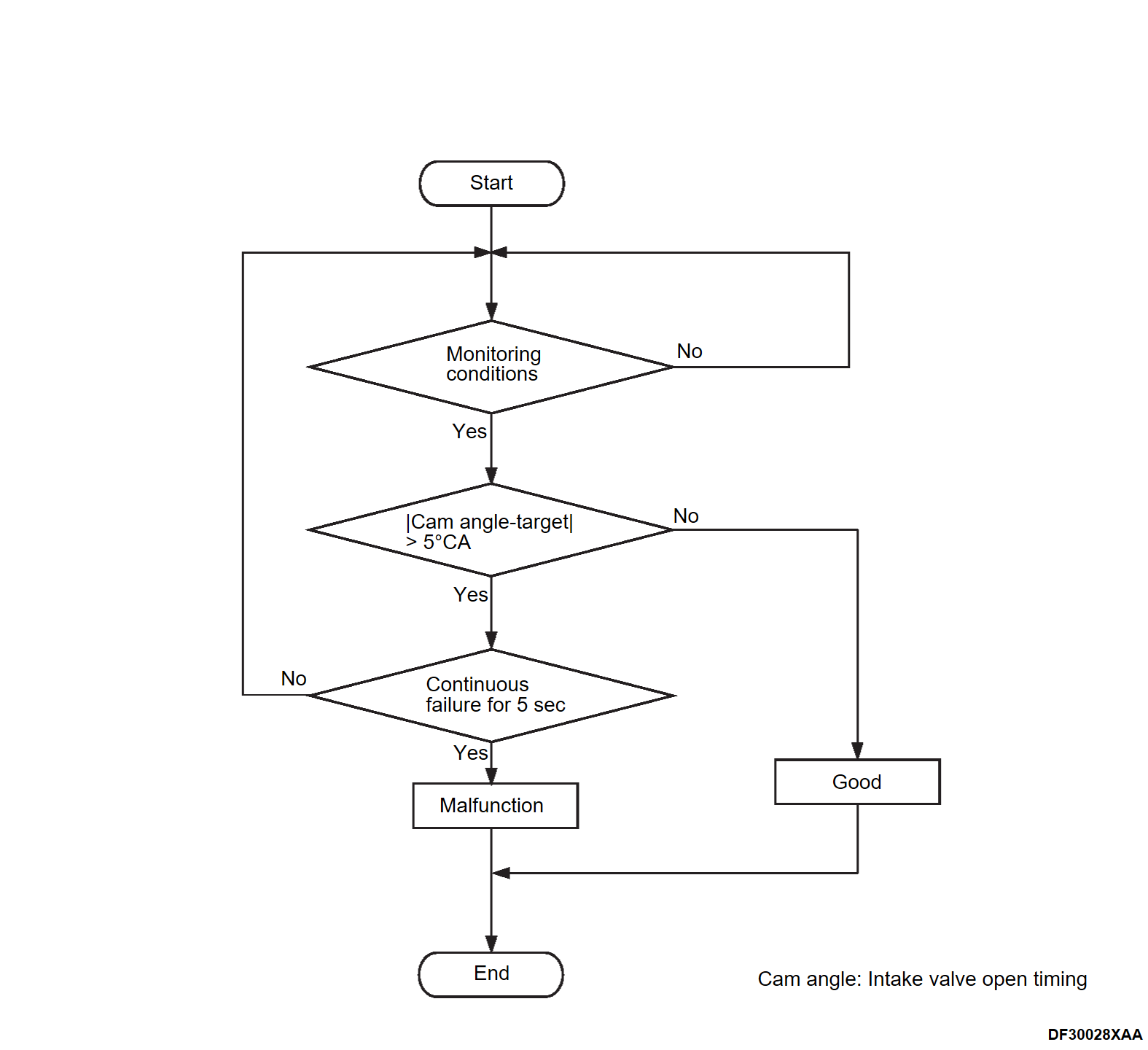DTC P0011: Variable valve timing system
TECHNICAL DESCRIPTION
The ECM checks the variable valve timing system for malfunction.
DESCRIPTIONS OF MONITOR METHODS
The difference between the actual intake valve opening timing and the intake valve target opening timing is over the specified value.
MONITOR EXECUTION
Continuous.
MONITOR EXECUTION CONDITIONS (Other monitor and Sensor)
Other Monitor (There is no temporary DTC set in memory for the item monitored below)
- Not applicable
Sensor (The sensor below is determined to be normal)
- Camshaft position sensor
- Crankshaft position sensor
- Engine coolant temperature sensor
- Throttle position sensor
- Oil feeder control valve
DTC SET CONDITIONS
Check Conditions
- More than 20 seconds have passed since the engine starting sequence was completed.
- Engine speed is higher than 1,188 r/min.
- Engine coolant temperature is higher than 76°C (169°F).
Judgment Criterion
- The difference between the actual intake valve opening timing and the intake valve target opening timing is more than 5°CA for 5 seconds.
FAIL-SAFE AND BACKUP FUNCTION
None.
OBD-II DRIVE CYCLE PATTERN
Refer to Diagnostic Function, OBD-II Drive Cycle – Pattern 5 OBD- II DRIVE CYCLE .
.
 .
.TROUBLESHOOTING HINTS (The most likely causes for this code to be set are:)
- Oil feeder control valve failed.
- Oil passage of variable valve timing control system clogged.
- Intake variable valve timing sprocket operation mechanism stuck.
- ECM failed.
DIAGNOSIS
Required Special Tools:
- MB992744: Vehicle communication interface-Lite (V.C.I.-Lite)
- MB992745: V.C.I.-Lite main harness A
- MB992747: V.C.I.-Lite USB cable short
- MB992748: V.C.I.-Lite USB cable long
1.STEP 1. Using scan tool (M.U.T.-III SE), check data list.
Use scan tool (M.U.T.-III SE) to check the data list (Refer to DATA LIST REFERENCE TABLE ).
).
 ).
).- Item number 200: V.V.T. RA(Intake-bank1)
Q: Is the check result normal?
2.STEP 2. Check oil feeder control valve itself.
Check oil feeder control valve itself (Refer to ENGINE OIL CONTROL VALVE CHECK ).
). Replace the oil feeder control valve (Refer to ENGINE, Engine Mechanical – Camshaft CAMSHAFT REMOVAL AND INSTALLATION
Replace the oil feeder control valve (Refer to ENGINE, Engine Mechanical – Camshaft CAMSHAFT REMOVAL AND INSTALLATION ).
).
 ).
).Q: Is the check result normal?
 Replace the oil feeder control valve (Refer to ENGINE, Engine Mechanical – Camshaft CAMSHAFT REMOVAL AND INSTALLATION
Replace the oil feeder control valve (Refer to ENGINE, Engine Mechanical – Camshaft CAMSHAFT REMOVAL AND INSTALLATION ).
).3.STEP 3. Check harness between oil feeder control valve connector terminal number 1 and ECM connector terminal number 9.
Check output line for damage. Repair or replace the connector, or repair the damaged harness wire.
Repair or replace the connector, or repair the damaged harness wire.
Q: Is the check result normal?
 Repair or replace the connector, or repair the damaged harness wire.
Repair or replace the connector, or repair the damaged harness wire.4.STEP 4. Check harness between IPDM E/R connector terminal number 66 and oil feeder control valve connector terminal number 2.
Check power supply line for damage. Repair or replace the connector, or repair the damaged harness wire.
Repair or replace the connector, or repair the damaged harness wire.
Q: Is the check result normal?
 Repair or replace the connector, or repair the damaged harness wire.
Repair or replace the connector, or repair the damaged harness wire.5.STEP 5. Check camshaft sensing portion.
Q: Is the check result normal?
 Replace the camshaft (intake side) (Refer to ENGINE – Engine Mechanical, Camshaft CAMSHAFT REMOVAL AND INSTALLATION
Replace the camshaft (intake side) (Refer to ENGINE – Engine Mechanical, Camshaft CAMSHAFT REMOVAL AND INSTALLATION ).
).6.STEP 6. Check intake V.V.T. sprocket operation mechanism for being stuck.
Q: Is the check result normal?
 Replace the intake V.V.T. sprocket assembly (Refer to ENGINE, Engine Mechanical – Camshaft CAMSHAFT REMOVAL AND INSTALLATION
Replace the intake V.V.T. sprocket assembly (Refer to ENGINE, Engine Mechanical – Camshaft CAMSHAFT REMOVAL AND INSTALLATION ).
).7.STEP 7. Check oil passage of variable valve timing control system for being clogged.
8.STEP 8. Test the OBD-II drive cycle.
After erasing the DTC, carry out test drive with the drive cycle pattern, and recheck the DTC. Replace the ECM (Refer to ENGINE CONTROL MODULE (ECM) REMOVAL AND INSTALLATION
Replace the ECM (Refer to ENGINE CONTROL MODULE (ECM) REMOVAL AND INSTALLATION ).
). Intermittent malfunction (Refer to GENERAL INFORMATION, General Information – How to Use Troubleshooting/Inspection Service Points – How to Cope with Intermittent Malfunctions HOW TO COPE WITH INTERMITTENT MALFUNCTIONS
Intermittent malfunction (Refer to GENERAL INFORMATION, General Information – How to Use Troubleshooting/Inspection Service Points – How to Cope with Intermittent Malfunctions HOW TO COPE WITH INTERMITTENT MALFUNCTIONS ).
).
(1) Use scan tool (M.U.T.-III SE) to erase the DTC.
(2) Carry out test drive with the drive cycle pattern (Refer to Diagnostic Function, OBD-II Drive Cycle – Pattern 5 OBD- II DRIVE CYCLE ).
).
 ).
).(3) Use scan tool (M.U.T.-III SE) to recheck the DTC.
Q: Is DTC P0011-00 set?
 Replace the ECM (Refer to ENGINE CONTROL MODULE (ECM) REMOVAL AND INSTALLATION
Replace the ECM (Refer to ENGINE CONTROL MODULE (ECM) REMOVAL AND INSTALLATION ).
). Intermittent malfunction (Refer to GENERAL INFORMATION, General Information – How to Use Troubleshooting/Inspection Service Points – How to Cope with Intermittent Malfunctions HOW TO COPE WITH INTERMITTENT MALFUNCTIONS
Intermittent malfunction (Refer to GENERAL INFORMATION, General Information – How to Use Troubleshooting/Inspection Service Points – How to Cope with Intermittent Malfunctions HOW TO COPE WITH INTERMITTENT MALFUNCTIONS ).
).![[Previous]](../../../buttons/fprev.png)
![[Next]](../../../buttons/fnext.png)
